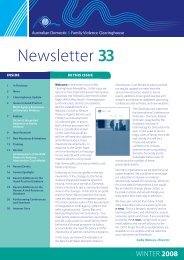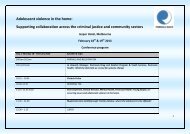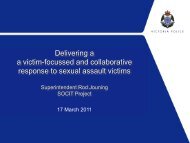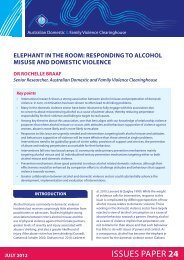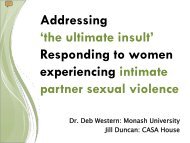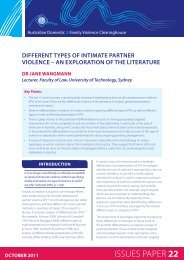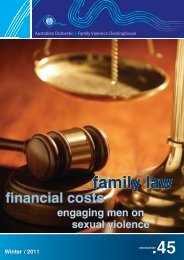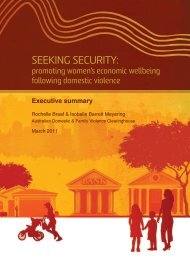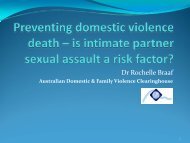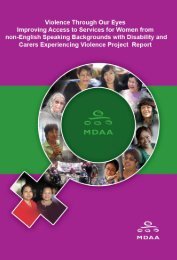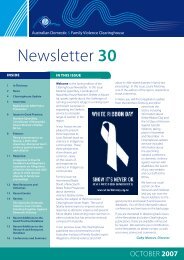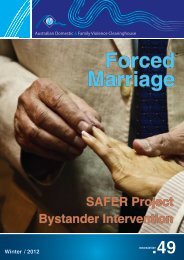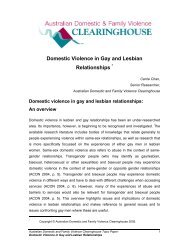newsletter - Australian Domestic and Family Violence Clearing House
newsletter - Australian Domestic and Family Violence Clearing House
newsletter - Australian Domestic and Family Violence Clearing House
Create successful ePaper yourself
Turn your PDF publications into a flip-book with our unique Google optimized e-Paper software.
Newsletter<br />
36<br />
Newsletter 36<br />
inside<br />
editorial<br />
1 editorial<br />
2 news<br />
3 CLEARINGHOUSE<br />
UPDATE<br />
4 ISSUES IN GOOD<br />
PRACTICE<br />
Multicultural identity <strong>and</strong><br />
working across cultures in<br />
responding to violence<br />
6 FEATURE<br />
The Road Home: an<br />
opportunity to address<br />
women, domestic <strong>and</strong><br />
family violence <strong>and</strong><br />
homelessness<br />
8 NEW RESOURCES &<br />
INITIATIVES<br />
9 NEW RESEARCH<br />
Criminal law <strong>and</strong> breaches<br />
of domestic violence<br />
protection orders<br />
10 PRACTICE NOTES<br />
‘Opening Closed Doors’<br />
project in Sydney’s Jewish<br />
community<br />
13 REVIEW<br />
<strong>Violence</strong> against Women in<br />
Melanesia <strong>and</strong> Timor-Leste<br />
14 RECENT ADDITIONS TO<br />
THE RESEARCH AND<br />
RESOURCES DATABASE<br />
15 RECENT ADDITIONS TO<br />
THE GOOD PRACTICE<br />
DATABASE<br />
16 FORTHCOMING<br />
CONFERENCES AND<br />
SEMINARS<br />
Welcome to the Autumn 2009 edition<br />
of the <strong>Clearing</strong>house Newsletter. The<br />
last few months have seen a number<br />
of innovations announced such as the<br />
introduction of homicide review processes<br />
in Victoria <strong>and</strong> New South Wales, a closer<br />
collaboration between the police <strong>and</strong><br />
child protection workers in some parts<br />
of Western Australia <strong>and</strong> introduction of<br />
m<strong>and</strong>atory reporting of domestic <strong>and</strong><br />
family violence in the Northern Territory.<br />
South Australia has called for more<br />
specialist domestic violence courts. There<br />
has also been a significant <strong>and</strong> pleasing<br />
acknowledgement in the White Paper on<br />
Homelessness, The Road Home, stating that<br />
exp<strong>and</strong>ed models of integrated support<br />
are needed to enable women <strong>and</strong> children<br />
experiencing domestic <strong>and</strong> family violence<br />
to remain safely in their own homes.<br />
While all of these initiatives may be valuable<br />
<strong>and</strong> effective strategies, this assortment<br />
of initiatives serves to illustrate the lack<br />
of consistency across the states <strong>and</strong><br />
territories in the way<br />
they deal with domestic<br />
<strong>and</strong> family violence.<br />
The <strong>Clearing</strong>house is<br />
eagerly awaiting the<br />
release of the National<br />
Plan produced by<br />
the National Council<br />
on <strong>Violence</strong> Against<br />
Women <strong>and</strong> their<br />
Children. We hope<br />
that this plan will<br />
incorporate strategies<br />
aimed at creating<br />
a more consistent<br />
approach to domestic<br />
<strong>and</strong> family violence across all states <strong>and</strong><br />
territories so that, irrespective of their<br />
location, victims of violence are able to<br />
receive the range of services they need<br />
to enable them to live free of violence.<br />
A problem of this dimension requires a<br />
national, united approach, with cooperation<br />
from all jurisdictions to invest in <strong>and</strong> commit<br />
to ending violence against women <strong>and</strong><br />
children.<br />
Those of you who are regular users of<br />
our website may have noticed our new<br />
Researchers Database. This new database<br />
brings together information about<br />
researchers working in the field of family <strong>and</strong><br />
domestic violence. If you are a researcher<br />
<strong>and</strong> would like to be added to this database<br />
or know someone who should be added<br />
please contact us. We are also improving<br />
our search functions on our Research <strong>and</strong><br />
Resources Database <strong>and</strong> welcome your<br />
feedback on both of these changes.<br />
Gaby Marcus, Director<br />
Rabbis participating in JewishCare’s ‘Opening Closed Doors’ project see pages 10 –12.<br />
autumn 2009
2<br />
news<br />
Criminology Research Council research<br />
grants – now open<br />
The 2009 round of Criminology Research Council<br />
research grants is now open. Closing date for<br />
applications: 21 August 2009. Documentation is<br />
available from the Criminology Research Council<br />
website.<br />
www.criminologyresearchcouncil.gov.au/<br />
applications/<br />
SA Rural Women’s Community Grants<br />
A small grants fund from the Office for Women,<br />
Government of South Australia, has been created<br />
for women in drought affected communities with<br />
three funding rounds in 2009. The Rural Women’s<br />
Community Grants 2009 provide organisations with<br />
an opportunity to receive small grants of up to $1000<br />
towards a community project that will build resilience<br />
within the community <strong>and</strong> support the continued<br />
work of local organisations. Closing dates for the<br />
second <strong>and</strong> third funding rounds are 30 June <strong>and</strong> 31<br />
October 2009.<br />
wis.sa.gov.au/index.phpsection=1079<br />
‘UNiTE to end violence against women’<br />
campaign gathers momentum<br />
The UN Secretary-Generals‘ campaign, ‘UNiTE to end<br />
violence against women’ campaign, 2008-2015, has<br />
the overall objective of raising public awareness <strong>and</strong><br />
increasing political will <strong>and</strong> resources for preventing<br />
<strong>and</strong> responding to all forms of violence against<br />
women <strong>and</strong> girls – in all parts of the world.<br />
www.un.org/womenwatch/daw/vaw/Words%20<br />
to%20Action%20Issue%20No.%202.pdf<br />
The Federal Government’s annual ‘Closing<br />
the Gap’ report released<br />
The Rudd Government released its first Annual Report<br />
on ‘Closing the Gap on Indigenous Disadvantage: the<br />
Challenge for Australia’, on 26 February 2009 to mark<br />
the one-year anniversary of the National Parliament’s<br />
apology to the Stolen Generations. The full report is<br />
available at:<br />
www.fahcsia.gov.au/indigenous/closing_the_gap/<br />
closing_the_gap.pdf<br />
Free subscription!<br />
For a free subscription to <strong>Clearing</strong>house<br />
publications, phone or fax us, or subscribe online.<br />
M<strong>and</strong>atory reporting laws passed in NT<br />
The Northern Territory Government has passed an<br />
amendment to its <strong>Domestic</strong> <strong>and</strong> <strong>Family</strong> <strong>Violence</strong> Act<br />
2007, that m<strong>and</strong>ates the reporting of domestic violence<br />
against both adults <strong>and</strong> children. The law requires<br />
all adults to report domestic violence if they believe<br />
another person’s life is in danger or they believe a<br />
person has caused, or is about to cause, serious harm to<br />
another person in a domestic relationship. The Territory<br />
Government will also commit $15 million over four<br />
years to support more crisis accommodation, increased<br />
counselling services <strong>and</strong> continuing public education<br />
campaigns surrounding the new law. More information<br />
about this radical amendment will be provided in the<br />
next edition of the <strong>Clearing</strong>house Newsletter.<br />
WA child protection workers to<br />
accompany police on call-outs<br />
The Western <strong>Australian</strong> (WA) Government has<br />
introduced a system whereby child protection workers<br />
will accompany police to domestic violence callouts<br />
across the Perth metropolitan area. The child<br />
protection officers will provide families with support<br />
<strong>and</strong> referrals for both men <strong>and</strong> women to domestic<br />
violence services. The move is based on a successful<br />
trial in Armadale <strong>and</strong> Cannington in WA, where it was<br />
seen to be responsible for a decrease in incidents.<br />
Hairdressers talking health<br />
The Body Shop Australia has provided<br />
a seeding grant for a project that will<br />
develop hairdressers’ skills in effective<br />
communication around relationship<br />
abuse <strong>and</strong> difficulties, as well as<br />
serious health issues, loss <strong>and</strong> grief<br />
<strong>and</strong> depression. The inaugural training<br />
workshops commenced in Victoria in<br />
February 2009.<br />
blog.thebodyshop.com.au/2009/01/hairdresserstalking-health.htm<br />
Training calenders available online<br />
Victoria<br />
<strong>Domestic</strong> <strong>Violence</strong> Resource Centre (Victoria) training<br />
calendar can be found at:<br />
www.dvrcv.org.au/TrainingHub/DVRC%20Tng%20<br />
Calendar%20Jan-June09.pdf<br />
NSW<br />
Education Centre Against <strong>Violence</strong>, NSW Health,<br />
course calendar can be found at:<br />
www1.health.nsw.gov.au/ecav/index.asppg=5&s=C<br />
<strong>newsletter</strong> 36
CLEARINGHOUSE UPDATE<br />
New services online<br />
Researchers Database: We have created a<br />
Researchers database where you can search for<br />
<strong>Australian</strong> researchers working in the field of<br />
domestic <strong>and</strong> family violence. This database will<br />
help connect researchers across the country <strong>and</strong><br />
those looking for research services. Please contact<br />
the <strong>Clearing</strong>house to add your details to the<br />
database.<br />
www.adfvc.unsw.edu.au/Researchers.htm<br />
Evaluation webpage: Evaluation is a critical<br />
element in improving strategies <strong>and</strong> building an<br />
evidence base. The <strong>Clearing</strong>house website has<br />
a new Evaluation webpage, where you will find<br />
information about evaluation guides, evaluations of<br />
programs <strong>and</strong> services, information about training,<br />
conferences <strong>and</strong> seminars, links <strong>and</strong> more.<br />
www.adfvc.unsw.edu.au/evaluation.htm<br />
Research <strong>and</strong> Resources Database: We’ve<br />
improved our Research <strong>and</strong> Resources database by<br />
breaking down some of the browse categories into<br />
sub-categories, to make searching easier <strong>and</strong> faster.<br />
We love to get your feedback, so let us know how<br />
you find these changes <strong>and</strong> anything else we can<br />
do to improve our services:<br />
clearinghouse@unsw.edu.au<br />
3<br />
We are also delighted to have Samira Ali <strong>and</strong><br />
Ariyan Daly, third year Social Work students from<br />
the University of New South Wales, with us for four<br />
months on their student placements. Sam <strong>and</strong> Ari are<br />
jointly working on a project involving a partnership<br />
with the Benevolent Society (BENSOC), NSW<br />
Older Women’s Network (OWN), the <strong>Family</strong> Abuse<br />
Prevention Center (YWCA NSW – South East Region)<br />
<strong>and</strong> the Sydney Women’s Counselling Center. The<br />
project partners are compiling a resource package<br />
to go out to general practitioners in NSW, informing<br />
them about the impact of domestic violence for their<br />
patients <strong>and</strong> providing referral pathways in their<br />
region, to support women seeking assistance. Ari<br />
is also assisting in a project involving independent<br />
research on women from the Pacific regions who are<br />
experiencing domestic violence, as well as examining<br />
the services, resources <strong>and</strong> support available to them<br />
locally, regionally <strong>and</strong> internationally.<br />
Seeking partners in research<br />
The <strong>Clearing</strong>house is seeking partners to conduct<br />
research projects over the next two years. We are<br />
interested in local, state <strong>and</strong> national projects that<br />
can inform a national perspective <strong>and</strong> underst<strong>and</strong>ing<br />
on family <strong>and</strong> domestic violence prevention. We are<br />
currently looking at the following areas:<br />
•the capacity of regional integrated strategies <strong>and</strong><br />
multi-purpose family violence services to address<br />
the challenges of family violence prevention in rural<br />
<strong>and</strong> remote Australia<br />
www.adfvc.unsw.edu.au<br />
New staff <strong>and</strong> students<br />
Sarah MacGregor joined the <strong>Clearing</strong>house team as<br />
a Research Assistant for three months this year. We<br />
thank her for her contribution to the research project<br />
examining ways to improve financial security for<br />
women victims of domestic violence in Australia, as<br />
well as her other research work. Sarah will soon take<br />
up a research position at the <strong>Australian</strong> Institute of<br />
Health <strong>and</strong> Welfare.<br />
The <strong>Clearing</strong>house is very pleased to welcome Andree<br />
Mansour as our Administration Officer. Andree<br />
previously worked in the <strong>Australian</strong> Graduate School of<br />
Management at the University of New South Wales <strong>and</strong><br />
started work with the <strong>Clearing</strong>house in mid March.<br />
•good practice in state-wide family violence referral<br />
systems<br />
•the hidden homelessness of single <strong>and</strong> older<br />
women, with a mapping exercise of service<br />
provision, barriers <strong>and</strong> gaps.<br />
If you are interested in speaking with us about these<br />
areas, please contact Gaby Marcus, Director, email:<br />
clearinghouse@unsw.edu.au<br />
New <strong>Clearing</strong>house paper<br />
•Campbell G, Steendam W, Little C & Marcus G 2009,<br />
Better Policing, Better Outcomes: changing police<br />
culture to prevent domestic violence <strong>and</strong> homicide,<br />
Issues Paper 18, <strong>Australian</strong> <strong>Domestic</strong> <strong>and</strong> <strong>Family</strong><br />
<strong>Violence</strong> <strong>Clearing</strong>house, Sydney<br />
Can’t wait for the Newsletter<br />
Subscribe to <strong>Clearing</strong>house e-news <strong>and</strong> get monthly updates on news, awards, grants, new books<br />
<strong>and</strong> reports, new resources, <strong>and</strong> conferences <strong>and</strong> events. Contact us or subscribe online.<br />
http://adfvc.unsw.edu.au<br />
<strong>newsletter</strong> 36
4<br />
ISSUES IN GOOD PRACTICE<br />
Multicultural identity <strong>and</strong><br />
working across cultures in<br />
responding to violence<br />
by Beata Ostapiej-Piatkowski<br />
<strong>and</strong> Stephanie Anne, Immigrant<br />
Women’s Support Service, QLD<br />
Practitioners communicate numerous<br />
concerns to us in relation to crosscultural<br />
practice in working with<br />
women from non-English speaking<br />
backgrounds (NESB 1 ) who have<br />
experienced violence.<br />
Of most concern are<br />
the confusions many<br />
practitioners hold<br />
in relation to being<br />
responsive to the issues<br />
of violence that women<br />
may be experiencing,<br />
<strong>and</strong> maintaining cultural<br />
sensitivity at the same<br />
time.<br />
The seemingly<br />
overwhelming difference between<br />
our own <strong>and</strong> another culture may<br />
lead to ‘professional paralysis’ <strong>and</strong><br />
feelings of cultural inadequacy in<br />
many practitioners, particularly<br />
in mainstream domestic violence<br />
services. Some may attempt to<br />
resolve this discomfort by refusing<br />
to take responsibility for the<br />
provision of services to women from<br />
NESB - apart from referring them to<br />
a multicultural <strong>and</strong>/or other specific<br />
agency. Others may provide<br />
a service but dismiss cultural<br />
discomfort <strong>and</strong> apply practice <strong>and</strong><br />
underst<strong>and</strong>ings based on a western<br />
analysis alone.<br />
It is important to underst<strong>and</strong> that the<br />
very cultural discomfort we are trying<br />
to avoid holds the potential for our<br />
exp<strong>and</strong>ed awareness. Following its<br />
direction will not only enrich our own<br />
self-underst<strong>and</strong>ing but also will allow<br />
us to perceive others on a deeper<br />
level, where human communication<br />
<strong>and</strong> connection replaces crosscultural<br />
fears.<br />
“It appears that we<br />
are comfortable<br />
to name violence<br />
when it comes to<br />
our own culture<br />
but shrink from<br />
naming it when it is<br />
perpetrated by <strong>and</strong><br />
to those whom we<br />
identify as ‘other’.”<br />
The issue of us <strong>and</strong> them –<br />
challenging false separations<br />
In giving some thought to the<br />
implicit messages of some crosscultural<br />
confusion, it is clear that<br />
many of us are confused as to the<br />
nature of our own community <strong>and</strong><br />
the nature of ‘culture’ itself.<br />
As a multicultural community<br />
Australia has diverse cultures,<br />
backgrounds, languages, spiritual<br />
beliefs, values <strong>and</strong> world views. It<br />
is critical to recognise that those<br />
differences of opinion, practices<br />
<strong>and</strong> perspectives on life<br />
are essential in building<br />
our social unity. The<br />
premise of <strong>Australian</strong><br />
multiculturalism is in<br />
acknowledgement<br />
that every individual<br />
contributes to<br />
the wholeness of<br />
our community.<br />
Consequently each<br />
individual has the<br />
right to be heard <strong>and</strong><br />
have his/her opinion respected,<br />
considered <strong>and</strong> included in all<br />
community endeavours.<br />
When we assert that we work<br />
with our community <strong>and</strong> yet we<br />
continue to consider elements<br />
of the <strong>Australian</strong> community as<br />
outside of our ability to engage,<br />
two implications are evident. Either<br />
we are not ready to recognise<br />
ourselves or ‘others’ as belonging<br />
to this diversity, or we are not able<br />
to work with what is humane. Of<br />
course, most <strong>Australian</strong> community<br />
workers would reject such an<br />
insinuation; however it is not the<br />
English language but our everyday<br />
actions that need to communicate<br />
our intention to work with diversity<br />
<strong>and</strong> our courage to engage.<br />
The flip-side of this contradiction<br />
is that it makes us feel inadequate<br />
whenever we are faced with the<br />
same aspects of diversity again.<br />
Moreover, the people whom<br />
we secretly ‘disown’ from the<br />
community sense this separation<br />
<strong>and</strong> then add to the distance by<br />
maintaining close connection only<br />
with those from similar culture.<br />
Often NESB women comment<br />
to Immigrant Women’s Support<br />
Service (IWSS) on their sense<br />
of isolation, which arises when<br />
they are supported by workers<br />
who never ask directly about the<br />
meaning of a woman’s culture <strong>and</strong>/<br />
or experience, while alluding to<br />
their own feelings of inadequacy<br />
<strong>and</strong> cross-cultural fear. It is no<br />
coincidence that whenever IWSS<br />
consults with new communities as<br />
to their needs during settlement,<br />
it is the need for acceptance above<br />
all that is expressed over <strong>and</strong> over<br />
again.<br />
Disturbingly, this imaginary division<br />
between ‘us’ <strong>and</strong> ‘them’ can, <strong>and</strong><br />
frequently has, become a very fertile<br />
ground for those in our community<br />
who seek power <strong>and</strong> control over<br />
others. At IWSS, we see too often<br />
the consequences of induced<br />
isolation <strong>and</strong> the strength that the<br />
sense of community belonging<br />
brings. Therefore, we need to be<br />
even more vigilant in responding<br />
to the voices of those who profess<br />
that it is within their cultural<br />
heritage to deny or abuse other<br />
people’s human rights. In working<br />
with domestic violence, this is<br />
particularly vital.<br />
<strong>Violence</strong> <strong>and</strong> culture –<br />
challenging cultural relativism<br />
It appears that we are comfortable<br />
to name violence when it comes<br />
to our own culture but shrink from<br />
naming it when it is perpetrated by<br />
<strong>and</strong> to those whom we identify as<br />
‘other’. This act alone suggests that<br />
still on some level we are inclined<br />
to believe that there are people<br />
for whom the ability to recognise<br />
violence <strong>and</strong> underst<strong>and</strong>ing of<br />
human rights do not apply.<br />
1 The term NESB in this article is used in recognition of the specific language barriers that may be experienced by those from diverse communities, who must<br />
learn another language while experiencing the many difficulties in transitioning to Australia. Culturally <strong>and</strong> linguistically diverse (CALD) women is otherwise<br />
used, as cultural diversity is not always based in language. There is no one single, official or State <strong>and</strong> Commonwealth-endorsed definition of the term CALD.<br />
The Victorian Multicultural Strategy Unit (2002) provides the following definition: ‘In the <strong>Australian</strong> context, individuals from a CALD background are those who<br />
identify as having a specific cultural or linguistic affiliation by virtue of their place of birth, ancestry, ethnic origin, religion, preferred language, language(s)<br />
spoken at home, or because of their parents identification on a similar basis.’<br />
<strong>newsletter</strong> 36
We often hear practitioners refer to<br />
women from NESB in the following<br />
ways: “they are so different”;<br />
“their culture is more violent<br />
<strong>and</strong> oppressive”; or “they do not<br />
recognise the law in Australia”.<br />
Whilst we acknowledge the many<br />
differences that exist between<br />
cultures, we also must acknowledge<br />
that violence against women is<br />
recognised by all cultures.<br />
It is crucial to<br />
underst<strong>and</strong> clearly the<br />
nature of violence <strong>and</strong><br />
to recognise it clearly<br />
without depending on<br />
identifying its cultural<br />
form or shape. The<br />
forms that violence<br />
takes are as diverse<br />
as humanity itself<br />
<strong>and</strong> though violence<br />
might appear in many<br />
different forms, some not easily<br />
perceived, its function is always<br />
the same. It does not always<br />
matter as much how things<br />
were done to the one who has<br />
experienced violence but it always<br />
matters what consequences it has<br />
had <strong>and</strong> what toll it takes.<br />
<strong>Violence</strong> does not hold its identity<br />
in culture. However, culture might<br />
be incorporated or employed<br />
in justification, underst<strong>and</strong>ing<br />
<strong>and</strong> responding to violence. It is<br />
this continuous justification that<br />
shifts the focus away from the toll<br />
violence takes <strong>and</strong> makes some<br />
types of violence invisible <strong>and</strong><br />
socially/culturally sanctioned or<br />
accepted. It is valuable if workers in<br />
mainstream services become aware<br />
“… whenever IWSS<br />
consults with new<br />
communities as to<br />
their needs during<br />
settlement, it is the<br />
need for acceptance<br />
above all that is<br />
expressed over <strong>and</strong><br />
over again.”<br />
5<br />
of this <strong>and</strong> of the impact it has on<br />
their work with women <strong>and</strong> children<br />
who bear the consequences of<br />
violence.<br />
Many forms of violence in our<br />
community are considered<br />
normal <strong>and</strong> culturally appropriate.<br />
Cultural appropriateness for<br />
women can embrace working 24<br />
hours a day, adopting masculine,<br />
often aggressive, ways, <strong>and</strong> being<br />
objectified, sexually.<br />
It is ‘normal’ for us<br />
to claim we have<br />
‘freedom’ of choice<br />
while the options of<br />
choice are non-existent<br />
or scarce. It is only<br />
when looking through<br />
a lens different from<br />
our own cultural<br />
perspective that we<br />
may get the clarity<br />
needed to identify violence in its<br />
many forms. Embracing diversity<br />
is certainly one way of increasing<br />
our perceptivity.<br />
Fear of engagement with<br />
diversity – challenging<br />
ourselves professionally<br />
To respond to the needs of our<br />
diverse community we must<br />
embrace its diversity <strong>and</strong> recognise<br />
it as our own. This recognition<br />
alone can lend us the thirst for<br />
knowing the true meaning of<br />
multiculturalism <strong>and</strong> of our own<br />
role within the community we wish<br />
to serve. There are no shortcuts<br />
when it comes to working with<br />
another human being. Either we<br />
work on the common level that<br />
touches us all, or we are not truly<br />
communicating.<br />
Cross-cultural practice does<br />
not depend on emphasising<br />
differences. The knowledge <strong>and</strong><br />
adherence to the infinite diversity<br />
of cultural practices <strong>and</strong> world<br />
views are important tools but<br />
do not constitute the essence<br />
of the practice itself. Crosscultural<br />
practice acknowledges<br />
the diversity as an inherent<br />
characteristic of our community<br />
<strong>and</strong> seeks to answer to its<br />
community needs on a platform<br />
that is respectful to the whole of<br />
humanity <strong>and</strong> therefore embraces<br />
all cultures. This respect includes<br />
engaging with women’s need for<br />
safety <strong>and</strong> underst<strong>and</strong>ing <strong>and</strong><br />
not avoiding this by off-loading<br />
through referrals to specialist<br />
NESB community organisations.<br />
The essence of integrating our own<br />
diversity is not about allowing some<br />
outside culture into our united<br />
system but it is about introspection<br />
<strong>and</strong> the courage to look deeply<br />
into our own identity where the<br />
old preconceptions, stereotypes<br />
<strong>and</strong> cognitive constructs built on<br />
the fear of difference still have their<br />
place.<br />
Of course, such an approach has<br />
its own requirements <strong>and</strong> can<br />
only be maintained by continuous<br />
self-reflection <strong>and</strong> refinement of<br />
our own individual cultural views.<br />
However much discomfort as we<br />
might meet, this path will lead<br />
the way towards honouring <strong>and</strong><br />
supporting the real application of<br />
multiculturalism in Australia.<br />
www.adfvc.unsw.edu.au<br />
About the Immigrant Women’s Support Service<br />
IWSS is the only service of its kind in Queensl<strong>and</strong> that provides culturally <strong>and</strong> linguistically<br />
sensitive services for women from NESB <strong>and</strong> their children who are victims of domestic<br />
<strong>and</strong> / or sexual violence. The service provides information <strong>and</strong> referral, crisis support <strong>and</strong><br />
counselling, advocacy, court support <strong>and</strong> ongoing practical <strong>and</strong> emotional support.<br />
Good Practice Hotline<br />
The <strong>Clearing</strong>house Good Practice Hotline is available on Wednesdays 2-4pm (Eastern St<strong>and</strong>ard Time).<br />
Call: (02) 9385 3843.<br />
<strong>newsletter</strong> 36
6<br />
FEATURE<br />
The Road Home: an opportunity to address<br />
women, domestic <strong>and</strong> family violence <strong>and</strong><br />
homelessness<br />
by Ludo McFerran, <strong>Clearing</strong>house Project Officer<br />
The Commonwealth Government’s White Paper<br />
on Homelessness The Road Home (FaHCSIA 2008)<br />
marks an important new direction in addressing<br />
homelessness in Australia through a range of<br />
strategies including:<br />
•recognising that the homeless population is not only<br />
made up of people who access funded supported<br />
accommodation services (SAAP),<br />
but also people who sleep rough<br />
or are in temporary <strong>and</strong> insecure<br />
accommodation<br />
•setting concrete targets to<br />
halve overall homelessness <strong>and</strong><br />
to offer accommodation to all<br />
people sleeping rough by 2020<br />
(COAG goals)<br />
•allocating $1.2 billion over<br />
the next four years as a ‘down<br />
payment’ on the 12-year reform<br />
agenda in the White Paper: $800<br />
million for services to prevent <strong>and</strong><br />
reduce homelessness <strong>and</strong> $400<br />
million to increase the supply of<br />
affordable <strong>and</strong> supported housing<br />
•positioning homelessness within<br />
a mainstream framework, specifically proposing to<br />
develop homelessness action plans with state <strong>and</strong><br />
territory governments, to improve collaboration<br />
between mainstream <strong>and</strong> homelessness services,<br />
<strong>and</strong>, importantly, implementing a ‘no exits into<br />
homelessness’ policy from statutory, custodial care,<br />
health, mental health <strong>and</strong> drug <strong>and</strong> alcohol services<br />
•in conjunction with states <strong>and</strong> territories, delivering<br />
exp<strong>and</strong>ed models to enable women <strong>and</strong> children<br />
experiencing domestic <strong>and</strong> family violence to remain<br />
at home safely, incorporating specialist outreach<br />
workers, brokerage funds for home security systems 1 ,<br />
<strong>and</strong> integrated family violence systems<br />
•recognising the complexities of the ageing of the<br />
homeless population <strong>and</strong> allocating aged care<br />
places <strong>and</strong> capital for new specialist facilities for the<br />
aged homeless<br />
•enhancing the role of Centrelink to advise <strong>and</strong><br />
assist people at risk of homelessness with 90 new<br />
Community Engagement Officers.<br />
The homelessness sector has reacted positively <strong>and</strong> is<br />
now scrutinising the detail. The capacity to deliver the<br />
ambitious reform agenda will largely depend on the<br />
outcome of negotiations with states <strong>and</strong> territories <strong>and</strong><br />
on the unfolding global economic downturn.<br />
Nevertheless, the White Paper is a strong indicator that the<br />
Commonwealth Government is prepared to address some<br />
of the entrenched problems of gender disadvantage in<br />
homelessness policy <strong>and</strong> provision, housing affordability<br />
<strong>and</strong> the double victimisation of women <strong>and</strong> children as<br />
a result of domestic <strong>and</strong> family violence. A gendered<br />
position on women <strong>and</strong> homelessness is critically needed.<br />
Recent research (Sharam 2008) has emphasised once again<br />
the invisibility of women’s homelessness when not directly<br />
linked to a recent incident of domestic or family violence,<br />
<strong>and</strong> predicted a significant increase in<br />
the numbers of pension aged women<br />
into the primary homeless population<br />
over the next 20 years.<br />
Old connections<br />
The relationship between<br />
homelessness <strong>and</strong> domestic <strong>and</strong><br />
family violence goes back a century<br />
<strong>and</strong> beyond. Religious organisations<br />
ran women’s hostels providing<br />
shelter for homeless women <strong>and</strong><br />
the Victorian YWCA opened its first<br />
women’s hostel in 1887. Women’s<br />
homelessness, however, remained<br />
largely overshadowed by that of<br />
men’s.<br />
The feminist inspired refuge<br />
movement in Australia in 1974-75 did<br />
not differentiate between women’s need for housing <strong>and</strong><br />
need for safety from domestic <strong>and</strong> family violence. In the<br />
first four months of opening, more than half the residents<br />
of Elsie Women’s Refuge had been recently discharged<br />
from psychiatric hospitals or were long-term, homeless<br />
single women. But increasingly, the lifestyles <strong>and</strong> needs<br />
of single women clashed with those of women with<br />
dependent children, which led to a policy of prioritising<br />
access for women with young children who had recent<br />
experience of domestic <strong>and</strong> family violence. Despite the<br />
opening of a small number of single women’s refuges in<br />
the 1980s, homeless single <strong>and</strong> older women issues were<br />
largely relegated again to obscurity.<br />
Ageing women have not been identified as a target<br />
group in domestic <strong>and</strong> family violence or homeless policy,<br />
legislation or services. The Government’s White Paper<br />
offers an opportunity to redress the neglect of single <strong>and</strong><br />
older homeless women that has been entrenched since<br />
the decline of the open door policy at Elsie.<br />
1 ‘Essential’ <strong>and</strong> integral’ is how Detective Superintendent Gerry Campbell from the London Metropolitan Police <strong>and</strong> Comm<strong>and</strong>er Colin Little from the Tasmanian<br />
Police described the capacity to install security systems in homes for women <strong>and</strong> children, at the <strong>Clearing</strong>house Forum, Better policing: Better Outcomes: Changing<br />
police culture to prevent domestic violence <strong>and</strong> domestic homicide, 4 December 2008, Sydney.<br />
<strong>newsletter</strong> 36
Ageing <strong>and</strong> homelessness<br />
Over the next 20-30 years Australia<br />
faces a crisis in housing affordability<br />
<strong>and</strong> safety for a wave of ageing<br />
female baby boomers many of<br />
whom live alone <strong>and</strong> lack the savings<br />
to enjoy old age (McFerran 2009).<br />
Already women constitute the bulk<br />
of the ageing population <strong>and</strong> older<br />
women a significant proportion of<br />
those who experience domestic <strong>and</strong><br />
family violence. 2 Yet these levels are<br />
not reflected in the concomitant<br />
access of older women to most<br />
domestic violence support services,<br />
including those that specifically<br />
provide housing (McFerran 2009).<br />
Older single, homeless women are<br />
likely to have experienced such<br />
trauma as sexual assault, domestic<br />
or family violence, poor mental<br />
<strong>and</strong> physical health <strong>and</strong> a range<br />
of substance <strong>and</strong> chemical abuse<br />
(Burich, et al. 2000). An apparent<br />
shortage of services catering to the<br />
needs of homeless single women<br />
means many are unable to access<br />
crisis accommodation (Robinson &<br />
Searby 2006; Sharam 2008).<br />
The <strong>Australian</strong> Institute of Health<br />
<strong>and</strong> Welfare (2008, p.3) annual report<br />
on homeless people in SAAP for<br />
2006-07 indicates that less than five<br />
percent of recurrent SAAP funding is<br />
allocated for single women <strong>and</strong> no<br />
recurrent funding for older women,<br />
as a primary group. To the best of<br />
the author’s knowledge, there is<br />
no funded crisis service specifically<br />
for older women in the country.<br />
As a consequence, for many older,<br />
homeless single women the situation<br />
is no better than during the 1970s.<br />
The exception is community housing<br />
where services, such as the Sydney<br />
Women’s Housing Company, have<br />
7<br />
been transformed over 20 years from<br />
a young single women’s service to<br />
an older women’s service. Robinson<br />
<strong>and</strong> Searby (2006) criticise the<br />
‘mismatch of crisis accommodation<br />
provision <strong>and</strong> models with likely<br />
crisis needs’ <strong>and</strong> recommended a<br />
‘re-examination of single homeless<br />
women as a significant homeless<br />
group in Australia’. The White Paper<br />
reform agenda offers an opportunity<br />
to set targets for appropriate longterm<br />
housing solutions for the ageing<br />
female population.<br />
There were a total of 683,322<br />
Aged Care Assessment Team<br />
<strong>and</strong> Home <strong>and</strong> Community Care<br />
clients aged 65 years <strong>and</strong> over in<br />
the year 2004-2005: two thirds<br />
of clients were women (AIHW<br />
2007). In contrast, older women<br />
who accessed SAAP for reasons of<br />
domestic violence or relationship<br />
breakdown in one year numbered<br />
only 1,279 3 . As these figures clearly<br />
indicate, the aged care sector is<br />
the major support system for older<br />
women, it is therefore critical to<br />
include this sector in an integrated<br />
response to domestic <strong>and</strong> family<br />
violence if we are to reduce <strong>and</strong><br />
prevent violence against older<br />
women. The introduction of the<br />
NSW Interagency Protocol for<br />
Responding to Abuse of Older<br />
People (NSW Department of Ageing,<br />
Disability <strong>and</strong> Home Care 2007)<br />
includes steps for staff to report<br />
domestic <strong>and</strong> family violence. The<br />
Protocol provides an imperative for<br />
interagency collaboration, including<br />
joint training with domestic<br />
violence workers, <strong>and</strong> for further<br />
opportunities to test new strategies<br />
<strong>and</strong> techniques to support older<br />
women remaining safely in their<br />
homes.<br />
References<br />
<strong>Australian</strong> Bureau of Statistics 2006,<br />
Personal Safety Survey, Australia, 2005,<br />
cat no 4906.0, ABS, Canberra<br />
<strong>Australian</strong> Institute of Health <strong>and</strong><br />
Welfare, Australia’s Welfare 2007, Cat.<br />
AUS 93, AGPS, Canberra<br />
<strong>Australian</strong> Institute of Health <strong>and</strong><br />
Welfare 2008, Homeless people in SAAP:<br />
SAAP National Data Collection annual<br />
report 2006-07 Australia, AGPS, Canberra<br />
Burich N, Hooder T, Teesson M 2000,<br />
Lifetime prevalence of trauma among<br />
homeless people in Sydney, <strong>Australian</strong><br />
<strong>and</strong> New Zeal<strong>and</strong> Journal of Psychiatry;<br />
34:963-966<br />
Chamberlain C & MacKenzie D 2008,<br />
Counting the Homeless, Australia 2006.<br />
<strong>Australian</strong> Bureau of Statistics, Canberra<br />
Harding <strong>and</strong> Smith unpublished, in<br />
McFerran L 1988 First Ten Years of the<br />
<strong>Australian</strong> Women’s Refuge Movement<br />
McFerran L 2009, ‘The disappearing age:<br />
a strategy to address violence against<br />
older women’, <strong>Clearing</strong>house Newsletter,<br />
issue 35, summer, pp. 6-7<br />
Robinson C & Searby R 2006,<br />
Accommodation in Crisis: Forgotten<br />
Women In Western Sydney, UTS<br />
Shopfront Research Monograph Series<br />
No.1, University of Technology, Sydney<br />
Sharam A 2008, Going it Alone: Single, Low<br />
Needs Women <strong>and</strong> Hidden Homelessness,<br />
Women’s Information, Support <strong>and</strong><br />
Housing in the North, Victoria<br />
Despite the challenging economic<br />
conditions, this Commonwealth<br />
Government declares itself<br />
committed to the long-term planning<br />
necessary to tackle homelessness.<br />
More than ever, it is time to ensure<br />
that being an ageing, single, older<br />
woman is not a barrier to be being<br />
safe, well <strong>and</strong> housed.<br />
www.adfvc.unsw.edu.au<br />
See the Homelessness White Paper:<br />
www.fahcsia.gov.au/housing/homelessness_white_paper<br />
Interagency Protocol:<br />
www.dadhc.nsw.gov.au/NR/rdonlyres/E38724C5-74FB-4768-AD4B-C9AFD1F39D53/2972/<br />
InteragencyProtocol1.pdf<br />
2 According to the ABS (2006) Personal Safety, Australia (2005) survey, one in four women who experienced an incident of physical violence in the past 12 months<br />
was aged 45 years <strong>and</strong> older. The greatest increase in reported cases of violence between the two national safety surveys (1996-2006) was against women over<br />
55 years old.<br />
3 Supported Accommodation <strong>and</strong> Crisis Services Unit, AIHW information provided to author: female SAAP clients aged 45 years <strong>and</strong> older whose main reason for<br />
seeking assistance was domestic or family violence or relationship or family breakdown in the year 2006-2007.<br />
<strong>newsletter</strong> 36
8<br />
NEW RESOURCES & INITIATIVES<br />
Victorian <strong>Family</strong> <strong>Violence</strong> Database (Volume<br />
3): Seven Year Trend Analysis Report<br />
Measuring <strong>Family</strong> <strong>Violence</strong> in Victoria, third in this<br />
series of reports, was released in January 2009 by the<br />
Department of Justice Victoria. It is the most recent<br />
update of a project begun in 1999 which analyses<br />
family violence incidents reported in that State. The<br />
database, now administered by the Victims Support<br />
Agency in the Department of Justice, incorporates<br />
data from Victoria Police family violence incident<br />
reports, Victorian Magistrates’ <strong>and</strong> Children’s Court<br />
finalised intervention order applications <strong>and</strong> the<br />
Victorian Supported Accommodation Assistance<br />
Program (SAAP). The seven year analysis (1999-2006)<br />
includes three new data sets: statistics from Victorian<br />
Public Hospital Emergency Departments, initial<br />
snapshot data from the Department of Justice Victims<br />
of Crime Helpline <strong>and</strong> the Department of Human<br />
Services Integrated Reporting <strong>and</strong> Information System<br />
(IRIS). The report’s three appendices provide police<br />
data, VEMD data <strong>and</strong> court data according to local<br />
government area (LGA). VEMD is the Victorian public<br />
hospital system category identifying human intent<br />
injuries caused by a family member.<br />
Victorian Public Hospital emergency presentations<br />
for family violence (VEMD) figures are recognised as<br />
an important inclusion in this kind of data collection,<br />
as two per cent of all injuries to women presenting to<br />
a hospital emergency department are considered to<br />
have been human intended <strong>and</strong> caused by domestic<br />
partners. The VEMD data also allows limited analysis of<br />
family violence among Indigenous <strong>and</strong> CALD persons<br />
<strong>and</strong>, for the first time, analysis of family violence<br />
among women with a disability is included.<br />
The Victims of Crime Helpline has also contributed<br />
one year of data to the report. This free service is<br />
confidential <strong>and</strong> information collected is voluntary<br />
<strong>and</strong> limited to the type of crime, gender of client, type<br />
of assistance provided <strong>and</strong> any other services already<br />
involved. <strong>Family</strong> violence (including child abuse)<br />
is the second most commonly reported crime <strong>and</strong><br />
constitutes 9.5 percent of all calls to the helpline.<br />
In the past four years family violence incident reports<br />
to the police have levelled off at around 28,000<br />
incidents <strong>and</strong> the ratio of male to female victims<br />
has remained consistent throughout the seven year<br />
collecting period. The steady increase in the number<br />
of children recorded as witnesses to family violence<br />
is seen as validating the increased training of police<br />
members in the awareness of the impact of family<br />
violence on children.<br />
There continue to be significant gaps <strong>and</strong> limitations<br />
in the data collection <strong>and</strong> there is an awareness of<br />
the need for data collection agencies to provide<br />
information in a way which is comparable across the<br />
various agencies, to better implement integrated<br />
responses to family violence. System reform over the<br />
past four years has seen an increase in the reporting<br />
of family violence <strong>and</strong> in the accountability of<br />
perpetrators, <strong>and</strong> it is hoped that a more complete<br />
picture of family violence reform will be illustrated<br />
at the end of 2009, once the new <strong>Family</strong> <strong>Violence</strong><br />
Protection Act <strong>and</strong> Victorian Police Safety Notices have<br />
been in place for 12 months.<br />
New <strong>Clearing</strong>house issues paper:<br />
Better Policing, Better Outcomes<br />
This latest Issues Paper from the <strong>Clearing</strong>house explores<br />
the ways in which three police agencies have better<br />
realised their capacity to keep people safe from domestic<br />
<strong>and</strong> family violence. In the paper, three senior police<br />
from different jurisdictions comment on the positive<br />
changes their organisations have made to address the<br />
issue of domestic <strong>and</strong> family violence. Some key themes<br />
emerge across the different jurisdictions about the<br />
elements essential to making change happen within<br />
police agencies <strong>and</strong> in public perceptions of police work<br />
around this crime. The paper is based on presentations<br />
on policing practice made by the authors at a<br />
<strong>Clearing</strong>house forum held in December 2008 in Sydney.<br />
Its publication follows the release of the Australasian<br />
Policing Strategy on the Prevention <strong>and</strong> Reduction of<br />
<strong>Family</strong> <strong>Violence</strong>, in November 2008. That document sets<br />
out priorities for action <strong>and</strong> performance measures for<br />
success in a framework to be taken up by each state <strong>and</strong><br />
territory in Australia <strong>and</strong> New Zeal<strong>and</strong>.<br />
Issues Paper 18 - available now<br />
Campbell G, Steendam W, Little C & Marcus G 2009,<br />
Better Policing, Better Outcomes: changing police<br />
culture to prevent domestic violence <strong>and</strong> homicide,<br />
Issues Paper 18, <strong>Australian</strong> <strong>Domestic</strong> <strong>and</strong> <strong>Family</strong><br />
<strong>Violence</strong> <strong>Clearing</strong>house, Sydney<br />
New international journal calls for papers<br />
A new international journal Partner Abuse published<br />
by Springer Publishing is calling for submission of<br />
papers. Partner Abuse wants to promote new work,<br />
research, interventions, policies, etc. pertaining to any<br />
aspect of family/intimate relational violence.<br />
www.springerpub.com/journal.aspxjid=1946-6560<br />
Changed your address<br />
If you’ve changed your address, email or other<br />
contact details, let us know so that we can update<br />
our mailing list. Please phone (02) 9385 2990 or<br />
email: clearinghouse@unsw.edu.au<br />
<strong>newsletter</strong> 36
Unique new website ‘HURT’ tells real stories<br />
9<br />
HURT is an online interactive virtual house containing embedded<br />
video clips of women, children <strong>and</strong> men describing their<br />
experiences of domestic <strong>and</strong> family violence. This one-of-a-kind<br />
resource hopes to raise the curtain on the hidden devastation<br />
<strong>and</strong> turmoil of domestic <strong>and</strong> family violence, breaking the barrier<br />
of shame <strong>and</strong> silence that so often surrounds women’s <strong>and</strong><br />
children’s experiences. The stories in HURT are true stories re-told<br />
by actors. Actors were used to preserve the privacy <strong>and</strong> safety<br />
of the survivors, perpetrators <strong>and</strong> service providers who shared their experiences. The website invites users to explore a<br />
virtually constructed house from the perspective of any one of 27 characters linked to more than 100 video clips.<br />
A DVD <strong>and</strong> training guide have been produced to facilitate the use of the HURT video clips in a training setting. The<br />
training resources are available from the Women’s Council: $25 for members, $50 for non-members, plus $2.50 postage<br />
<strong>and</strong> h<strong>and</strong>ling. To obtain a copy contact Nicole or Janette on (08) 9420 7264 or policy@womenscouncil.com.au The<br />
Women’s Council for <strong>Domestic</strong> <strong>and</strong> <strong>Family</strong> <strong>Violence</strong> Services (WA) launched HURT in November 2008 in conjunction with<br />
the State’s White Ribbon Day activities. The project was funded by the Office for Women, Department of Families, Housing,<br />
Community Services <strong>and</strong> Indigenous Affairs.<br />
www.hurt.net.au<br />
www.adfvc.unsw.edu.au<br />
NEW RESEARCH<br />
Criminal law <strong>and</strong> breaches of domestic<br />
violence protection orders<br />
by Dr Heather Douglas, Senior Lecturer, TC Beirne<br />
School of Law, University of Queensl<strong>and</strong><br />
Scholars <strong>and</strong> activists have long campaigned for<br />
domestic violence to be recognised as criminal<br />
offending. At the same time, however, they have<br />
consistently demonstrated how criminalisation of<br />
domestic violence <strong>and</strong> the processes associated<br />
with criminalisation frequently impose further<br />
harm on women. This research draws on a study<br />
of 645 criminal prosecutions of breaches of<br />
domestic violence protection orders in south east<br />
Queensl<strong>and</strong> magistrates’ courts in 2005. It explores<br />
the process of criminal intervention in this context.<br />
This study found that although criminal breach<br />
charges are laid, criminal responsibility is often<br />
minimised by police prosecution authorities in<br />
terms of the type of charge applied. For example,<br />
breach charges were preferred even where the<br />
offence was identified by police as assault or<br />
criminal damage. Furthermore, the research found<br />
that defendants minimised their responsibility in<br />
the offending conduct, often by blaming the victim.<br />
This study reveals several key findings:<br />
•that defendants charged with breach of a<br />
domestic violence order are less likely to plead<br />
guilty than defendants charged with nondomestic<br />
violence matters<br />
•defendants are more likely to be legally<br />
represented in breach matters<br />
•criminal prosecutions of domestic violence matters<br />
will take longer to finalise than other criminal<br />
matters heard in the Magistrates courts, <strong>and</strong><br />
•overwhelmingly breach charges will result in<br />
fines, usually under $200.<br />
In most cases sentencing justices fail to tailor an<br />
appropriate sentencing response that takes into<br />
account the particular background of the offence<br />
<strong>and</strong> the relationship between the perpetrator<br />
<strong>and</strong> the victim. In many cases examined in this<br />
study, the victim was drawn into the prosecution<br />
process to assist in withdrawing charges or to<br />
support mitigation of penalty. The approaches of<br />
respondents, police, lawyers <strong>and</strong> magistrates in<br />
colluding in the minimisation <strong>and</strong> trivialisation of<br />
violence <strong>and</strong> the shifting of blame to the victim in<br />
the course of applying criminal justice responses<br />
were recognised in this study <strong>and</strong> have been<br />
recognised elsewhere. The impact of this approach<br />
is that it inflicts further harm on women.<br />
The research explores whether there are shifts <strong>and</strong><br />
changes that can be made in this area of criminal<br />
law so that it better embraces the three principles of<br />
justice that have been identified by Barbara Hudson:<br />
discursiveness, relationalism <strong>and</strong> reflectiveness.<br />
For discussion of this research see:<br />
Douglas H 2008, ‘The Criminal Law’s Response to<br />
<strong>Domestic</strong> <strong>Violence</strong>: What’s Going On’ Sydney Law<br />
Review, vol. 30, no 3, pp. 439-469<br />
Douglas H 2007, ‘Not a Crime Like Any Other:<br />
Sentencing Breaches of <strong>Domestic</strong> <strong>Violence</strong><br />
Protection Orders’ Criminal Law Journal, vol. 31, no.<br />
4, pp. 200-233<br />
<strong>newsletter</strong> 36
10<br />
PRACTICE NOTES<br />
‘Opening Closed Doors’ project in Sydney’s<br />
Jewish community<br />
by Roberta Freedman, Program Manager <strong>Family</strong> <strong>and</strong><br />
Children’s Service, JewishCare, <strong>and</strong> Rochelle Braaf,<br />
<strong>Clearing</strong>house Senior Research Officer<br />
About JewishCare<br />
JewishCare is a non-government organisation,<br />
providing welfare services to the Jewish<br />
community of NSW. Contact: phone: 1300 133<br />
660, PO Box 647, Bondi Junction NSW 1355.<br />
Raising public awareness of domestic violence,<br />
gaining support of community leaders to encourage<br />
disclosure <strong>and</strong> referral to domestic violence services,<br />
<strong>and</strong> providing relevant information <strong>and</strong> support to<br />
victims of violence is a challenging, long term project<br />
in any community. These tasks can be more complex<br />
in culturally <strong>and</strong> linguistically diverse (CALD) groups,<br />
such as the Jewish community in Sydney, which is<br />
multi layered <strong>and</strong> comprises many different language<br />
groups <strong>and</strong> levels of religious belief.<br />
To address these issues, JewishCare ran the Opening<br />
Closed Doors project in 2007-08 in Sydney’s Jewish<br />
community, a one-year community development<br />
project, funded by the Office for Women, Department<br />
of Families, Housing, Community Services <strong>and</strong><br />
Indigenous Affairs. JewishCare sought to raise<br />
awareness about domestic <strong>and</strong> family violence,<br />
<strong>and</strong> sexual assault in a culturally sensitive way, in<br />
diverse parts of the Jewish community, <strong>and</strong> to enable<br />
women facing domestic <strong>and</strong> family violence to find<br />
appropriate professional help when they need it.<br />
Prior to the Opening Closed Doors project, JewishCare’s<br />
experience of working on these issues indicated that<br />
many Jewish people do not accept that there is domestic<br />
<strong>and</strong> family violence or sexual assault in their community.<br />
Even among those who agree that it does exist, there is a<br />
level of denial <strong>and</strong> surprise as to the extent or seriousness<br />
of the violence, <strong>and</strong> a professed lack of confidence in<br />
Workshop with Rebbitzen (wives of Rabbis) who are key sources of<br />
information in the Jewish community.<br />
how to help someone experiencing such violence. There<br />
are strong family <strong>and</strong> community values that prevent<br />
some members <strong>and</strong> groups from accessing mainstream<br />
domestic <strong>and</strong> family violence prevention services <strong>and</strong><br />
general community education about these issues. There<br />
are also cultural concepts <strong>and</strong> values that may prevent a<br />
woman telling others of her experiences, such as ‘shame’<br />
<strong>and</strong> that the role of the wife is to ‘keep peace in the home’<br />
(‘shalom bayit’).<br />
In addition, the project faced complex requirements<br />
to not just raise awareness about domestic <strong>and</strong> family<br />
violence but also to educate about how to respond,<br />
what might be helpful for women, children <strong>and</strong> families<br />
affected by violence, what is culturally appropriate <strong>and</strong><br />
more likely to be accepted. In addition, JewishCare<br />
needed to harness community development principles,<br />
as well as cultural <strong>and</strong> religious knowledge, for the<br />
project to be effective.<br />
Innovative strategies<br />
The Opening Closed Doors project represents an<br />
innovative community development approach, aiming to<br />
reach cultural <strong>and</strong> religious leaders in the different parts<br />
of the community <strong>and</strong> to encourage people affected by<br />
domestic violence to seek help. There were many different<br />
components of the project, including 26 community<br />
events held during February - March 2008.<br />
The project staff:<br />
•conducted a community survey in the Jewish<br />
community in Sydney of underst<strong>and</strong>ing <strong>and</strong><br />
awareness of domestic <strong>and</strong> family violence, <strong>and</strong><br />
sexual assault<br />
•designed, printed <strong>and</strong> distributed a culturally<br />
appropriate pamphlet <strong>and</strong> card with information<br />
about domestic <strong>and</strong> family violence, <strong>and</strong> healthy<br />
relationships <strong>and</strong> where to get help<br />
•conducted workshops for non-Jewish professionals,<br />
such as hospital social workers, psychologists, local<br />
welfare agencies, police <strong>and</strong> legal professionals, to<br />
provide training about the cultural <strong>and</strong> religious<br />
issues which may st<strong>and</strong> in the way of a woman<br />
seeking help<br />
•conducted workshops on healthy relationships in<br />
four Jewish schools for years 10, 11 <strong>and</strong> 12, attended<br />
by approximately 360 students<br />
•ran self-defence classes for women including<br />
mothers <strong>and</strong> daughters, people with disabilities <strong>and</strong><br />
older women<br />
•engaged a speaker from Jewish Women International,<br />
Deborah Rosenbloom, who led many of the workshops.<br />
Inviting an international speaker highlighted the<br />
professional nature of the project <strong>and</strong> attracted<br />
considerable media attention for all the events she was<br />
involved with <strong>and</strong> for the project as a whole<br />
<strong>newsletter</strong> 36
11<br />
www.adfvc.unsw.edu.au<br />
Rabbis attending training sessions<br />
•established a Taskforce<br />
comprising female cultural<br />
<strong>and</strong> religious leaders; e.g. two<br />
Rebbitzen (wives of Rabbis), a<br />
magistrate, local professionals,<br />
<strong>and</strong> women in high community<br />
involvement <strong>and</strong> leadership roles.<br />
In terms of successful outcomes,<br />
JewishCare established partnerships<br />
with other organisations, for<br />
example Woollahra Council, to run<br />
self-defence classes <strong>and</strong> with other<br />
Jewish organisations to run specific<br />
workshops. A successful initiative was<br />
the Taskforce, particularly as members<br />
came from different parts of the<br />
community <strong>and</strong> represented natural<br />
<strong>and</strong> formal networks in communal<br />
life. In terms of reach of the project,<br />
more than 1,000 adults <strong>and</strong> young<br />
people attended 28 workshops <strong>and</strong><br />
many more were reached through<br />
articles in the local Jewish newspaper,<br />
posters, flyers <strong>and</strong> a domestic<br />
violence information card produced<br />
as part of the project.<br />
JewishCare commissioned the<br />
<strong>Australian</strong> <strong>Domestic</strong> <strong>and</strong> <strong>Family</strong><br />
<strong>Violence</strong> <strong>Clearing</strong>house to advise<br />
them on reviewing the project<br />
<strong>and</strong> refining strategies used by the<br />
project. A great deal of positive<br />
feedback was received from those<br />
who participated in events <strong>and</strong><br />
suggestions for improvements were<br />
made, including provision of more<br />
information. Some people were less<br />
engaged with the issues <strong>and</strong> less<br />
convinced of the seriousness of this<br />
form of violence, which signifies the<br />
need for further intervention.<br />
Opportunities<br />
The nature of relationships,<br />
structures <strong>and</strong> methods of<br />
communication within the Jewish<br />
community presented particular<br />
opportunities to reach out to<br />
diverse sections of the community.<br />
Networks ranging from the religious<br />
observant to secular groups<br />
presented different possibilities<br />
in terms of people who could be<br />
approached. For example, the<br />
Rabbis <strong>and</strong> Rebbitzen play an<br />
important role in supporting <strong>and</strong><br />
working with their congregations.<br />
Educating these two groups has a<br />
flow-on effect, enabling information<br />
about violence within families to<br />
be extended to those who would<br />
not usually attend these kinds of<br />
seminars.<br />
Within the Jewish community there<br />
are natural, informal leaders who<br />
play educational <strong>and</strong> support roles<br />
for people having family difficulties.<br />
Opening Closed Doors targeted<br />
these individuals <strong>and</strong> they went on<br />
to play a major role in the project by<br />
encouraging others to attend events,<br />
<strong>and</strong> providing their homes as venues.<br />
JewishCare realised the importance<br />
of including women who manage<br />
the ‘mikvahs’ (communal ritual<br />
baths), which are a key part of<br />
observant life <strong>and</strong> are an important<br />
avenue for providing information to<br />
the community. They were invited to<br />
training sessions <strong>and</strong> asked to make<br />
available the domestic violence<br />
information cards for women<br />
attending the mikvahs.<br />
The project used specialised media<br />
to educate the community about<br />
domestic <strong>and</strong> family violence, <strong>and</strong><br />
sexual assault <strong>and</strong> where to get help;<br />
e.g. synagogue <strong>newsletter</strong>s <strong>and</strong> other<br />
publications aimed at particular<br />
groups, such as observant women.<br />
Challenges<br />
Some of the challenges posed by<br />
working with the Jewish community<br />
are common to all CALD communities,<br />
such as dealing with small, close-knit<br />
communities, making it difficult for<br />
victims to seek help <strong>and</strong> stay in the<br />
community, feelings of shame about<br />
this issue as well as language <strong>and</strong><br />
cultural issues specific to the individual<br />
cultures <strong>and</strong> religions.<br />
The Jewish community has strengths<br />
that can also present challenges to this<br />
type of work. Certain attitudes may<br />
prevent a woman seeking help for<br />
violence in the home, for example:<br />
<strong>newsletter</strong> 36
12<br />
•the belief that a woman is responsible for making a<br />
good <strong>and</strong> peaceful home or ‘shalom bayit’<br />
•the view that gossip or ‘lashon hara’ is not acceptable<br />
- often interpreted as not being able to tell someone;<br />
e.g. a Rabbi, about what someone else is doing to you,<br />
such as abusive behaviour, <strong>and</strong><br />
•feelings of ‘shonda’ or ‘shame’ in revealing that violence<br />
is occurring.<br />
Such community beliefs may be the backbone of a<br />
strong community but can become obstacles when a<br />
woman needs to seek help for violence in the home.<br />
A major challenge of the project was ensuring that<br />
these values were taken into account in the seminars<br />
<strong>and</strong> workshops in communities <strong>and</strong> schools. This meant<br />
being aware of culturally acceptable language around<br />
these issues, being able to convey the nature <strong>and</strong><br />
manifestations of domestic <strong>and</strong> family violence <strong>and</strong><br />
sexual assault in acceptable terms <strong>and</strong> knowing the ways<br />
to best present the information.<br />
Accomplishments<br />
The goal of the project was achieved to the extent that<br />
the project did indeed ‘open doors’ <strong>and</strong> trigger discussion<br />
about these issues. JewishCare noted an increase in<br />
referrals for domestic violence, both self-referred <strong>and</strong> by<br />
key people in the community. There were more phone<br />
calls from Rabbis <strong>and</strong> Rebbitzen contacting JewishCare<br />
for advice <strong>and</strong> information in the period following the<br />
project. The subject is much more openly discussed<br />
amongst different groups in the Jewish community.<br />
The Taskforce has formally separated from JewishCare<br />
to become the Jewish Alliance Against <strong>Family</strong> <strong>Violence</strong><br />
(JAAFV). This extremely active <strong>and</strong> committed group<br />
of women has sought incorporation <strong>and</strong> is planning<br />
events to continue raising awareness of domestic <strong>and</strong><br />
family violence <strong>and</strong> sexual assault in the community.<br />
Several Rabbis <strong>and</strong> Rebbitzen are now very aware of<br />
the issue <strong>and</strong> its effect on women <strong>and</strong> children, <strong>and</strong> are<br />
active in speaking about it from the synagogue. Three<br />
Rabbis ran ‘shiurs’ (educational talks) for women <strong>and</strong> their<br />
congregations after the training they received, with one<br />
Rabbi from the observant community running a shiur<br />
about domestic violence, attended by 70 women, the<br />
day after participating in Rabbinical training.<br />
Staff training in domestic violence has broadened<br />
JewishCare’s capacity to provide services to families<br />
experiencing domestic violence. The organisation<br />
continues to work in the area through its <strong>Family</strong><br />
Support Program <strong>and</strong> to raise awareness including<br />
running a successful White Ribbon Day breakfast for<br />
men <strong>and</strong> a T-shirt printing day for NSW Stop <strong>Domestic</strong><br />
<strong>Violence</strong> Day in November 2008.<br />
Limitations<br />
The nature of the project’s one-year funding was a<br />
major limitation affecting longevity of outcomes. It<br />
meant that while an enormous amount of work was<br />
successfully completed, further funding needed to be<br />
sought to work on sustaining the impetus. Part of the<br />
success of this project was the intensity of the number<br />
of events <strong>and</strong> circulation of information through as<br />
many media as possible. The lack of ongoing funding<br />
prevents JewishCare continuing this process <strong>and</strong><br />
achieving ongoing social change <strong>and</strong> education,<br />
especially through the small communal networks<br />
<strong>and</strong> meetings. The one-year time funding agreement<br />
for the project also placed significant pressure<br />
on implementing the project quickly. A longer<br />
timeframe may have been even more beneficial than<br />
an extension of funding, in order to engage in longterm<br />
community capacity building.<br />
A lack of time also impacted on quality control. One<br />
of the tasks that was not implemented due to lack of<br />
time was inviting an external organisation such as the<br />
NSW Education Centre Against <strong>Violence</strong> to vet written<br />
material <strong>and</strong> workshop content. This process would<br />
have allowed for independent scrutiny of concepts,<br />
principles, messages <strong>and</strong> modes of delivery. Instead,<br />
these were developed based on the experience of<br />
JewishCare staff who have worked in the area of<br />
domestic <strong>and</strong> family violence prevention for many<br />
years. The short timeframe also meant that some<br />
strategies have not been completed, for example<br />
working with synagogues to have the domestic<br />
violence card in all toilets <strong>and</strong> bathroom facilities. This<br />
is an important next step in the community education<br />
process <strong>and</strong> in maintaining the momentum.<br />
Where to next<br />
JewishCare hopes to continue the work established<br />
by the project, subject to availability of staff <strong>and</strong><br />
successful application for further funding, <strong>and</strong> to<br />
continue partnership, support for <strong>and</strong> work with<br />
JAAFV. JewishCare wishes to revisit the results for the<br />
project to inform future work of this kind.<br />
The organisation would like to continue training for<br />
Rabbis <strong>and</strong> Rebbitzen <strong>and</strong> community education in<br />
schools, in partnership with JAAFV, <strong>and</strong> to continue<br />
training community leaders on a more formal basis.<br />
In addition, NSW Health’s Education Centre Against<br />
<strong>Violence</strong> has agreed to run a training program for<br />
Jewishcare in August 2009 which will enable ongoing<br />
staff development to ensure JewishCare continues to<br />
provide appropriate professional services in the area<br />
of domestic violence.<br />
Prefer to get this Newsletter by email<br />
If so, please let us have your email address <strong>and</strong> we will gladly email it to you: clearinghouse@unsw.edu.au<br />
<strong>newsletter</strong> 36
REVIEW<br />
<strong>Violence</strong> against Women in Melanesia <strong>and</strong><br />
Timor-Leste<br />
reviewed by Ludo McFerran, <strong>Clearing</strong>house Project<br />
Officer<br />
The report <strong>Violence</strong> Against Women in Melanesia <strong>and</strong><br />
East Timor (2008), by AusAID’s Office of Development<br />
Effectiveness, is an assessment of the effectiveness<br />
of current approaches to reducing violence in Fiji,<br />
PNG, Solomon Isl<strong>and</strong>s, Vanuatu <strong>and</strong> East Timor. It is<br />
a sobering account of the disadvantage <strong>and</strong> danger<br />
experienced by many women <strong>and</strong> girls in our region,<br />
the challenges faced by local women with few<br />
resources to provide support <strong>and</strong> drive change, <strong>and</strong><br />
the positive role that <strong>Australian</strong>s can play.<br />
“If a girl has to stay late at school, she has to walk home alone,<br />
<strong>and</strong> then she can be raped.” (Vanuatu)<br />
“Girls can get raped at high school or at primary school by the<br />
teachers. It’s a common thing.” (PNG)<br />
“The father takes the money <strong>and</strong> sends the girl to the logging<br />
camp. Or they negotiate for the logger to build a house or buy<br />
an outboard motor. Some girls are only 14 or 15.” (Solomon<br />
Isl<strong>and</strong>s)<br />
“Even after the tensions, women married to men from the<br />
opposite side were still being raped.” (Solomon Isl<strong>and</strong>s)<br />
13<br />
(p.17). Other problematic practices include polygamy<br />
<strong>and</strong> the payment of compensation to the males with<br />
rights over a women who has been injured (father,<br />
brother, husb<strong>and</strong>) in the interest of ‘maintaining peace<br />
between groups <strong>and</strong> their male leaders’ (p.18).<br />
Every country has at least one crisis support service for<br />
women experiencing violence, though most are run by<br />
NGOs on a shoestring with support from international<br />
aid agencies. Very few receive core funding or national<br />
government funds. Only the centres in Timor-Leste<br />
provide onsite emergency shelter <strong>and</strong> most centres<br />
are in urban areas, though the majority of women live<br />
in rural areas. The report identifies limited access to<br />
services, poor coordination between services <strong>and</strong> the<br />
uneven quality of service as barriers for women <strong>and</strong> girls<br />
seeking support.<br />
Nevertheless, there has been significant progress<br />
made under difficult circumstances. The report cites<br />
as examples of promising practice, the inspiring<br />
work of the Fiji Women’s Crisis Centre, the Vanuatu<br />
Women’s Centres <strong>and</strong> the network of VAW Committees<br />
in Vanuatu, <strong>and</strong> the establishment of a safe space in<br />
Dili Hospital to treat victims of domestic violence,<br />
sexual assault <strong>and</strong> child abuse. Health services<br />
are identified as capable of playing a critical role<br />
in supporting women <strong>and</strong> girls. One-stop shops<br />
at health clinics that integrate medical care <strong>and</strong><br />
counselling with police <strong>and</strong> legal services <strong>and</strong> shelter<br />
are recommended.<br />
<strong>Violence</strong> Against Women in Melanesia <strong>and</strong> East Timor<br />
challenges the <strong>Australian</strong> domestic <strong>and</strong> family violence<br />
sector to better underst<strong>and</strong> the lives of women <strong>and</strong><br />
children in our region, both those now living in Pacific<br />
communities within Australia, <strong>and</strong> those still living in<br />
their own countries. It challenges us to explore the<br />
possibilities for support <strong>and</strong> exchange that closer ties<br />
across our region could produce.<br />
www.ode.ausaid.gov.au/publications/pdf/vaw_cs_<br />
full_report.pdf<br />
www.adfvc.unsw.edu.au<br />
Despite the limited research that has been conducted<br />
on violence against women in Melanesia <strong>and</strong> East<br />
Timor, studies by the PNG Law Reform Commission<br />
(1992) <strong>and</strong> the Fiji Women’s Crisis Centre (1999) report<br />
alarming rates of violence, with two in every three<br />
women reporting being physically abused by their<br />
partners. Collaborative research in East Timor (Hynes<br />
et al. 2003) found that intimate partner violence<br />
<strong>and</strong> sexual violence are the most common forms of<br />
violence in the country.<br />
For the <strong>Violence</strong> Against Women in Melanesia <strong>and</strong> East<br />
Timor report, an evaluation team made site visits<br />
to each country, conducting interviews with key<br />
individuals, including survivors. Local researchers<br />
were trained to conduct further interviews <strong>and</strong> focus<br />
groups in rural areas. Consequently, a great strength<br />
of the report is the authenticity of the evidence from<br />
local people that clearly demonstrates the danger of<br />
daily life for many women <strong>and</strong> girls (p.13).<br />
The report found that the low status of women in the<br />
region is ‘a major obstacle to reducing violence against<br />
them’ reinforced by a number of customary practices.<br />
Bride price (except for Fiji) was cited with economic<br />
dependence as the biggest factors in perpetuating<br />
violence against wives because it relegates women<br />
to the status of property: “I bought her for $5000. I<br />
can do anything with her. She’s my property not yours”<br />
<strong>newsletter</strong> 36
14<br />
RECENT ADDITIONS TO THE RESEARCH<br />
AND RESOURCES DATABASE<br />
Herrenkohl TI, Sousa C, Tajima EA, Herrenkohl RC,<br />
Moylan CA 2008, ‘The intersection of child abuse<br />
<strong>and</strong> children’s exposure to domestic violence’,<br />
Trauma, <strong>Violence</strong> & Abuse, vol. 9, no. 2, pp. 84-99<br />
The authors of this article examine the overlap in<br />
physical child abuse <strong>and</strong> domestic violence, the<br />
prediction of child outcomes, <strong>and</strong> resilience in<br />
children exposed to family violence. They explore<br />
current findings within the context of other risk<br />
factors, including community violence <strong>and</strong> related<br />
family <strong>and</strong> environmental stressors. They find there is<br />
overlap as well as compounding effects <strong>and</strong> possible<br />
gender differences in outcomes of violence exposure.<br />
Patrick R, Cook K, McKenzie H 2008, ‘<strong>Domestic</strong><br />
violence <strong>and</strong> the exemption from seeking child<br />
support: providing safety or legitimizing ongoing<br />
poverty <strong>and</strong> fear’, Social Policy <strong>and</strong> Administration,<br />
vol. 42, no. 7, pp. 749-767<br />
This article examines the <strong>Australian</strong> experience of lowincome<br />
women on welfare seeking child support from<br />
a violent ex-partner, <strong>and</strong> contrasting this with findings<br />
from the United States <strong>and</strong> the United Kingdom.<br />
The article explores the option of giving women an<br />
exemption from seeking child support if this process<br />
places them <strong>and</strong> their children at risk, <strong>and</strong> outcomes<br />
of this policy. The authors argue that the needs of<br />
women <strong>and</strong> their children can be compromised<br />
by policy specifications <strong>and</strong> the way policies are<br />
implemented.<br />
Peri K, Fanslow J, H<strong>and</strong> J, Parsons J 2008, Elder<br />
abuse <strong>and</strong> neglect: exploration of risk <strong>and</strong> protective<br />
factors: a report for the Families Commission,<br />
Families Commission, Wellington [NZ]<br />
This report looks at identifying risk <strong>and</strong> protective<br />
factors surrounding the neglect <strong>and</strong> abuse of older<br />
people. A range of older people, health professionals,<br />
service providers <strong>and</strong> representatives of ethnic groups<br />
<strong>and</strong> regions were sampled for qualitative information.<br />
Data were collected through face-to-face, telephone<br />
<strong>and</strong> focus group interviews. Risk factors for abuse<br />
<strong>and</strong> neglect included isolation <strong>and</strong> increasing<br />
physical (<strong>and</strong> sometimes mental) challenges<br />
associated with aging, overburdened or greedy family<br />
members, staffing issues in residential care settings,<br />
undervaluing of older people in society, cost of living<br />
<strong>and</strong> unavailability of care. Protective factors included<br />
supportive families, well trained <strong>and</strong> well paid staff<br />
in residential care settings <strong>and</strong> social connectedness.<br />
Institutions like banks, lawyers, churches, faith<br />
communities <strong>and</strong> police could also play a positive role.<br />
Spangaro J, Zwi AB, Poulos R 2008, ‘The elusive<br />
search for definitive evidence on routine screening<br />
for intimate partner violence’, Trauma, <strong>Violence</strong> &<br />
Abuse, vol. 10, no. 1, pp. 55-68<br />
Routine screening for intimate partner violence<br />
(IPV) has been introduced in many health settings to<br />
improve identification <strong>and</strong> responsiveness to IPV, amid<br />
continuing debate. Three assumptions have impeded<br />
progress in measuring the impact of screening: that<br />
routine screening is a test only, <strong>and</strong> does not of itself<br />
have an impact on patients; that it can be assessed<br />
by evaluating interventions provided to women<br />
after abuse is identified through screening, <strong>and</strong> that<br />
there can be an agreed appropriate intervention for<br />
IPV. In addition, there are significant impediments<br />
to evaluating screening as an intervention through a<br />
r<strong>and</strong>omised control trial. These include identification<br />
of the study group, isolating the control group from<br />
the intervention, ethics, lack of baseline data <strong>and</strong><br />
recall bias. In researching this area, a range of study<br />
designs is required <strong>and</strong> a rethink of assumptions is<br />
needed.<br />
Welsh K 2008, ‘Partnerships or palming off:<br />
involvement in partnership initiatives on domestic<br />
violence’, The Howard Journal of Criminal Justice,<br />
vol. 47, no. 2, pp. 170-188<br />
The author suggests that partnership initiatives are<br />
largely driven by voluntary sector organisations<br />
<strong>and</strong> that although some state agencies show a real<br />
commitment to attending, involvement from other<br />
state agencies is disappointing at best. The author<br />
discusses what this reveals about who carries the<br />
burden of partnership responses to domestic violence,<br />
<strong>and</strong> what it suggests about the effectiveness of<br />
partnership initiatives <strong>and</strong> whether such initiatives<br />
are entitled to be afforded such significance in<br />
government policy.<br />
Looking for a researcher<br />
Find <strong>Australian</strong> researchers working in the<br />
field of domestic <strong>and</strong> family violence on the<br />
<strong>Clearing</strong>house Researchers Database. You can<br />
search for researchers by name, research area,<br />
institution or by keywords.<br />
If you want to be listed on the <strong>Clearing</strong>house<br />
Researchers Database, please contact us:<br />
clearinghouse@unsw.edu.au<br />
<strong>newsletter</strong> 36
RECENT ADDITIONS TO THE GOOD<br />
PRACTICE DATABASE<br />
Through Young Black Eyes Workshop Kit<br />
This collection of training <strong>and</strong> education materials<br />
has been compiled by the Secretariat of National<br />
Aboriginal <strong>and</strong> Isl<strong>and</strong>er Child Care (SNAICC) to assist<br />
communities to address family <strong>and</strong> domestic violence<br />
in Indigenous communities <strong>and</strong> reduce its impact<br />
on children <strong>and</strong> young people. Innovative features<br />
include SNAICC’s willingness to make materials<br />
freely <strong>and</strong> widely available <strong>and</strong> encourage changes<br />
based on community needs. The workshop kit is a<br />
continuous ‘work in progress’ designed for adaptation<br />
<strong>and</strong> feedback from colleagues around the country. It<br />
is available in hard copy, downloadable or CD ROM<br />
formats.<br />
15<br />
Koora the Kangaroo project<br />
This school-based community education project<br />
aims to address children’s attitudes to violence in<br />
the central western Queensl<strong>and</strong> community of<br />
Woorabinda. The project revolved around stories<br />
written by local community member, Ailsa Weazel, <strong>and</strong><br />
the development of a Koora “mascot” to accompany<br />
story telling. The project targeted Indigenous<br />
children at the Woorabinda State School <strong>and</strong> also<br />
included school visits by local community members.<br />
Queensl<strong>and</strong>’s Centre for <strong>Domestic</strong> <strong>and</strong> <strong>Family</strong> <strong>Violence</strong><br />
Research (CDFVR) supported the program through<br />
assistance with project development, printing of<br />
resources, including illustrated stories <strong>and</strong> evaluation.<br />
publicising an event<br />
Let us help you<br />
www.adfvc.unsw.edu.au<br />
The NPY (Ngaanyatjarra, Pitjantjatjara,<br />
Yankunytjatjara) <strong>Family</strong> <strong>Violence</strong> Program<br />
This perpetrator program arose from the Cross Border<br />
Justice Project of the Western <strong>Australian</strong>, South<br />
<strong>Australian</strong> <strong>and</strong> Northern Territory Governments. It<br />
aims to address family violence in the NPY l<strong>and</strong>s of<br />
Central Australia, through group work with offenders<br />
across the borders of the three jurisdictions which<br />
cross these l<strong>and</strong>s. The project is managed from the<br />
Northern Territory Department of Justice office in<br />
Alice Springs <strong>and</strong> involves extensive travel to remote<br />
Indigenous communities to conduct four to five week<br />
programs with perpetrators.<br />
Are you holding an event such as a forum or<br />
seminar, or launching a campaign or resource<br />
Contact us to include it in our Newsletter, email<br />
alert <strong>and</strong> on the website.<br />
Get your contribution into the<br />
next issue!<br />
The closing date for contributions to the winter<br />
issue of the Newsletter is 13 May 2009. Be sure to<br />
send in accompanying photos <strong>and</strong> images!<br />
REMEMBER to contact the <strong>Clearing</strong>house for<br />
information on how to register your program on<br />
the Good Practice Database.<br />
Publication information<br />
The views expressed in this Newsletter do not necessarily represent the views of the <strong>Australian</strong> <strong>Domestic</strong> <strong>and</strong><br />
<strong>Family</strong> <strong>Violence</strong> <strong>Clearing</strong>house or the <strong>Australian</strong> Government. While all reasonable care has been taken in the<br />
preparation of this publication, no liability is assumed for any errors or omissions. The <strong>Australian</strong> <strong>Domestic</strong> <strong>and</strong><br />
<strong>Family</strong> <strong>Violence</strong> <strong>Clearing</strong>house is funded by the Safety Taskforce, <strong>Australian</strong> Government Department of Families,<br />
Housing, Community Services <strong>and</strong> Indigenous Affairs. The <strong>Clearing</strong>house is linked to the Centre for Gender-<br />
Related <strong>Violence</strong> Studies, based in the University of New South Wales, School of Social Sciences <strong>and</strong> International<br />
Studies.<br />
ISSN: 1443 – 7236<br />
© 2009<br />
<strong>Australian</strong> <strong>Domestic</strong> & <strong>Family</strong> <strong>Violence</strong> <strong>Clearing</strong>house<br />
The University of New South Wales<br />
NSW Australia 2052<br />
p: +61 2 9385 2990 f: +61 2 9385 2993 freecall: 1800 753 382 e: clearinghouse@unsw.edu.au<br />
w: www.adfvc.unsw.edu.au<br />
<strong>newsletter</strong> 36
16<br />
FORTHCOMING CONFERENCES<br />
AND SEMINARS<br />
Working with women affected by<br />
domestic violence: a strengths-based,<br />
safety-focused approach<br />
1 May 2009 – Glebe, NSW<br />
This workshop aims to help social workers to<br />
recognise the skills they already have to assist clients<br />
affected by domestic violence, <strong>and</strong> to provide an<br />
evidence-based model for approaching this work.<br />
www.aasw.asn.au/about/branches/nsw_files/<br />
WorkingwithWomenAffectedby<strong>Domestic</strong><strong>Violence</strong>-<br />
010509.pdf<br />
2009 Anaheim International Conference<br />
on Sexual Assault, <strong>Domestic</strong> <strong>Violence</strong> &<br />
Stalking<br />
18-20 May 2009 - Anaheim, USA<br />
This three day conference is aimed at law-enforcement<br />
personnel, prosecutors, victim advocates, judges,<br />
parole <strong>and</strong> probation officers, rape crisis workers,<br />
medical personnel, faith community members,<br />
educators <strong>and</strong> others, highlighting promising<br />
practices <strong>and</strong> emerging issues in sexual assault,<br />
domestic violence <strong>and</strong> stalking.<br />
www.evawintl.org/conferences.aspx<br />
From Ideology to Inclusion 2009: New<br />
Directions in <strong>Domestic</strong> <strong>Violence</strong> Research<br />
<strong>and</strong> Intervention<br />
26-28 June 2009 – Los Angeles, USA<br />
Billed as ‘the domestic violence conference of the<br />
decade’, topics include aetiology <strong>and</strong> risk factors,<br />
dynamics of partner violence, partner abuse in<br />
a cultural context, <strong>and</strong> effectiveness of batterer<br />
intervention programs.<br />
www.favtea.com<br />
<strong>Australian</strong> Social Policy Conference<br />
8-10 July 2009 - Sydney, NSW<br />
How can we build an inclusive society This theme is a<br />
topic of growing importance in social policy – <strong>and</strong> one<br />
that is central to the stated aims of the Rudd Labor<br />
Government. At a time of global economic insecurity,<br />
exacerbated by the challenges of climate change, the<br />
conference explores how we create a society that is<br />
both socially <strong>and</strong> economically inclusive within its<br />
own borders <strong>and</strong> actively engaged with its regional<br />
neighbours to promote a wider form of global<br />
inclusiveness.<br />
www.sprc.unsw.edu.au/ASPC2009/index.htm<br />
Making it Happen! Sixth<br />
Women <strong>and</strong> Policing<br />
conference<br />
23-26 August 2009 – Perth, WA<br />
The theme of the 2009 women<br />
<strong>and</strong> policing conference is<br />
“Making it Happen”. Delegates will<br />
explore practical <strong>and</strong> innovative<br />
solutions to improving policing for<br />
women – how police services respond to their female<br />
employees <strong>and</strong> how policing responds to women in<br />
the community.<br />
www.acwap.com.au/conferences/conf09.html<br />
CLC National Conference<br />
14-17 September 2009 - Perth, WA<br />
The National Association of Community Legal Centres<br />
(NACLC) has held an annual conference every year<br />
since 1979. This conference provides an important<br />
opportunity for workers from CLCs to get together<br />
<strong>and</strong> learn from each other, hear from inspirational <strong>and</strong><br />
interesting speakers <strong>and</strong> recharge their batteries.<br />
www.naclc.org.au/conference<br />
8th ISPCAN Asia Pacific Regional<br />
Conference on Child Abuse & Neglect<br />
15-18 November 2009 – Perth, WA<br />
The conference theme is ‘Child Abuse <strong>and</strong> Neglect:<br />
Looking Through the Lens of Prevention’ in<br />
recognition of the need to focus attention on the<br />
creation of holistic approaches that engage children<br />
<strong>and</strong> families, communities, professionals, business<br />
<strong>and</strong> governments in preventing child abuse. Early bird<br />
registration closes 14 August 2009.<br />
www.apccan2009.org.au/index.html<br />
<strong>newsletter</strong> 36



